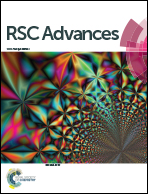Biotransformative removal of cationic Red X-GRL by anaerobic activated sludge†
Abstract
The decolorization of azo dyes can be easily achieved by anaerobic activated sludge, while further degradation of the aromatic amines is a challenge for treating azo dye wastewater. The anaerobic activated sludge material, which was cultured in an anaerobic unflow biological filter, was used directly for decolorizing and degrading the cationic Red X-GRL (X-GRL). The anaerobic activated sludge is mainly composed of the bacteria belonging to phyla Proteobacteria and Firmicutes, and the archaea belonging to phylum Methnomicrobiales. The cultured anaerobic sludge has been demonstrated efficient for treating X-GRL wastewater. All color and more than 95% of aromatic amines were removed with an X-GRL concentration of 200 mg L−1 and a hydraulic retention time (HRT) of 60 h. Batch assays were employed to investigate the anaerobic biotransformation of X-GRL. The sucrose added to the influent acts as an initial electron donor for the reduction of the azo bond, generating colorless aromatic amines. Aromatic amines were then completely degraded to CO2, CH4 and NH3 by anaerobic activated sludge, avoiding the secondary pollution by the dye pollutant. Finally, the transformation pathway of X-GRL under the anaerobic conditions was proposed. Therefore, the anaerobic activated sludge material is demonstrated as a sustainable material for the biotransformative removal of azo dyes from wastewater.


 Please wait while we load your content...
Please wait while we load your content...